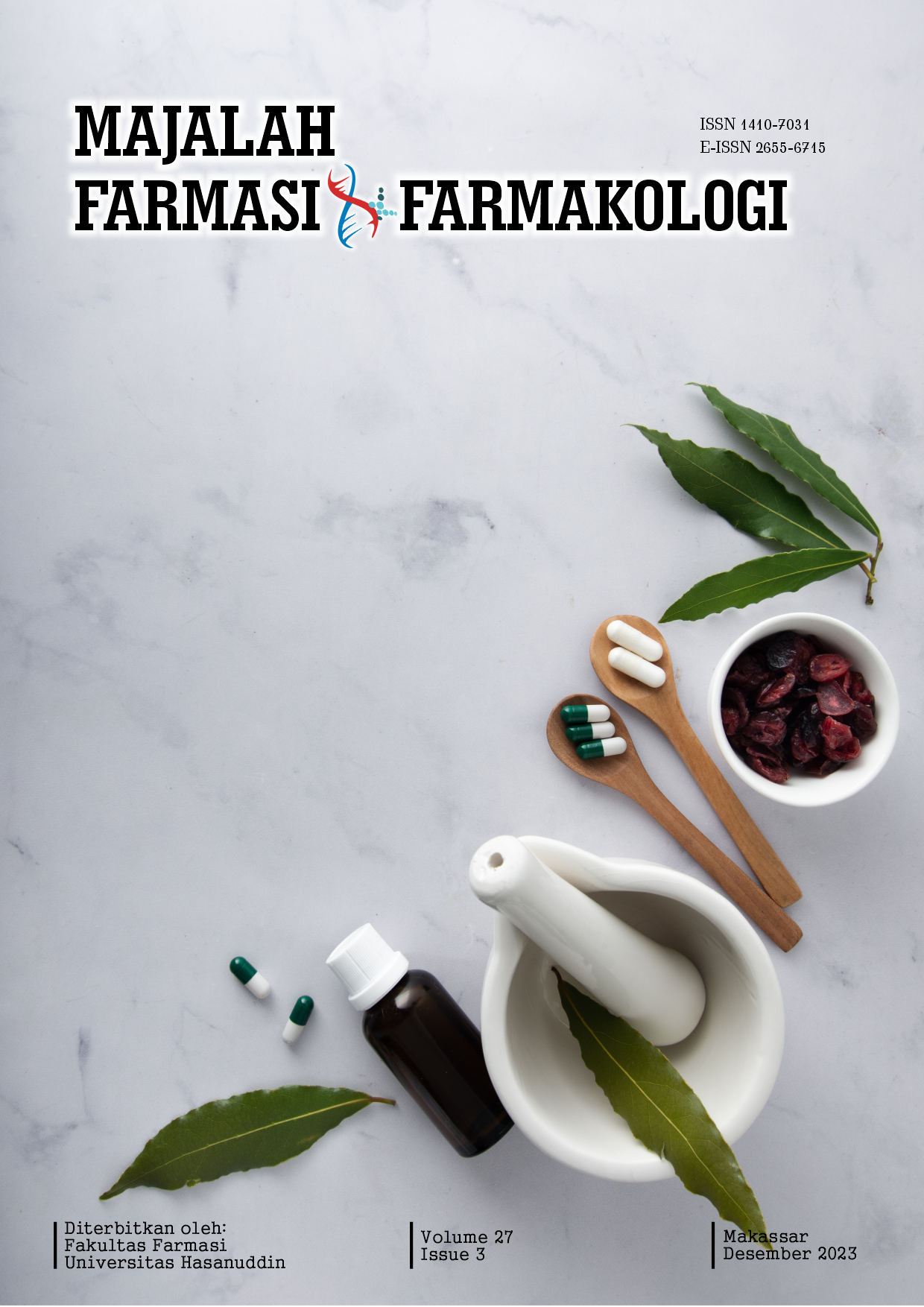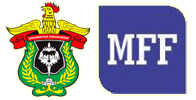ISOLASI DAN IDENTIFIKASI ETHYL P-METHOXYCINNAMATE (EPMC) DARI RIMPANG KENCUR (Kaempheria galanga) SEBAGAI KANDIDAT SENYAWA ANTIKANKER
Keywords:
Isolasi dan Identifikasi, Ethyl P-Methoxycinnamate, soxhlet, ekstrak metanolAbstract
Indonesia kaya akan keanekargaman tanaman obat. Salah satunya adalah rimpang kencur atau Kaempferia galanga L. Tanaman ini memiliki potensi besar sebagai sumber penting senyawa bioaktif yang dapat mendukung pengembangan obat-obatan alami serta mendorong penelitian lebih lanjut dalam bidang farmakologi dan pengobatan. Kaempferia galanga sendiri telah diteliti mengandung beragam senyawa yang dapat dimanfaatkan untuk berbagai aktivitas farmakologi salah satunya adalah antikanker. Salah satu komponen senyawa yang dimiliki oleh Kaempferia galanga yang dapat digunakan sebagai antikanker adalah etil p-methoxycinnamate (EPMC). Penelitian ini bertujuan untuk mengisolasi dan mengidentifikasi senyawa EPMC untuk memperoleh hasil isolasi yang maksimal dengan kadar EPMC yang tinggi. Metode isolasi EPMC dari tanaman kencur menggunakan soxhlet sebagai alat ekstraksi. Identifikasi dan penentuan kadar senyawa diperoleh menggunakan evaluasi KLT, GC-MS, NMR, HPLC dan Spektrofotometri UV-Vis. Hasil identifikasi menunjukkan isolat dari Kaempheria galanga merupakan senyawa ethyl p-methoxycinnamate dengan berat molekul 206 dan persentase kadar EPMC menunjukkan kadar yang tinggi baik menggunakan HPLC maupun spektrofotometer UV-Vis, dimana kadar EPMC dalam isolat didapatkan sebesar 90,40 ± 3,62 %, dan 91,29 ± 3,66 %. Sedangkan untuk kadar pada ekstrak metanol Kaempheria galanga adalah 49,57 ± 0,63 % dan 40,61± 0,25% berdasarkan hasil HPLC dan spektrofotometer UV-Vis. Berdasarkan hasil tersebut dapat disimpulkan bahwa metode isolasi EPMC dari tanaman kencur (Kaempferia galanga) menggunakan soxhlet sebagai alat ekstraksi memberikan rendemen ekstrak dan rendemen isolat yang tinggi.References
Afifa, R. M., Kusuma, W. A., & Annisa, A. (2022). Ontology Data Modeling of Indonesian Medicinal Plants and Efficacy. INTENSIF: Jurnal Ilmiah Penelitian dan Penerapan Teknologi Sistem Informasi, 6(2), 218-232.
Atanasov, A. G., Zotchev, S. B., Dirsch, V. M., & Supuran, C. T. (2021). Natural products in drug discovery: Advances and opportunities. Nature reviews Drug discovery, 20(3), 200-216.
Balunas, M. J., & Kinghorn, A. D. (2005). Drug discovery from medicinal plants. Life sciences, 78(5), 431-441.
Batubara, I., Assaat, L., Irawadi, T., Mitsunaga, T., & Yamauchi, K. (2011). Effect of sniffing of kencur (Kaemferia galangal) essential oils in rats. International Symposium on Medicinal and Aromatic Plants 1023,
Chowdhury, M. Z., Al Mahmud, Z., Ali, M. S., & Bachar, S. C. (2014). Phytochemical and pharmacological investigations of rhizome extracts of Kaempferia galanga. Int. J. Pharmacogn, 1(3), 185-192.
Elshamy, A. I., Mohamed, T. A., Essa, A. F., Abd-El Gawad, A. M., Alqahtani, A. S., Shahat, A. A., ... & Hegazy, M. E. F. (2019). Recent advances in Kaempferia phytochemistry and biological activity: A comprehensive review. Nutrients, 11(10), 2396.
Elya, B., Kusuma, I. M., Jufri, M., & Handayani, R. (2016). Antibacterial tests against acne in vitro, the physical stability and patch test using cream containing ethyl p-methoxycinnamate extracted from Kaempferia galanga L., Rhizoma. Research Journal of Medicinal Plant, 10(8), 426-434.
Hakim, A., Andayani, Y., & Rahayuan, B. D. (2018). Isolation of ethyl p-methoxy cinnamate from Kaemferia galanga L. Journal of Physics: Conference Series,
Harvey, A. L. (2008). Natural products in drug discovery. Drug discovery today, 13(19-20), 894-901.
Hasali, N. H. M., Omar, M. N., Zuberdi, A. M., & Alfarra, H. Y. (2013). Biotransformation of ethyl p-methoxycinnamate from Kaempferia galanga L. using Aspergillus niger. International Journal of Biosciences, 3(7), 148-155.
Ichwan, S. J., Husin, A., Suriyah, W. H., Lestari, W., Omar, M. N., & Kasmuri, A. R. (2019). Anti-neoplastic potential of ethyl-p-methoxycinnamate of Kaempferia galanga on oral cancer cell lines. Materials Today: Proceedings, 16, 2115-2121.
Kumar, A. (2020). Phytochemistry, pharmacological activities and uses of traditional medicinal plant Kaempferia galanga L.–An overview. Journal of ethnopharmacology, 253, 112667.
Lallo, S., Hardianti, B., Sartini, S., Ismail, I., Laela, D., & Hayakawa, Y. (2022). Ethyl P-Methoxycinnamate: An Active Anti-Metastasis Agent and Chemosensitizer Targeting NFκB from Kaempferia galanga for Melanoma Cells. Life, 12(3), 337.
Nasution, R., Candein, C. N., Saidi, N., Bahi, M., & Marianne, M. (2021). Isolation of Ethyl p-Methoxycinnamate from Azadirachta indica Root Bark as Hong Kong Caterpillar (Tenebrio molitor) Antifeedant. Indonesian Journal of Chemistry, 21(6), 1348-1357.
Salim, A. A., Chin, Y. W., & Kinghorn, A. D. (2008). Drug discovery from plants. Bioactive molecules and medicinal plants, 1-24.
Prasetyo, Prasetyo dan Entang, Inoriah Sukarjo., (2013) PEMBUATAN SIMPLISIA. In: PENGELOLAAN BUDIDAYA TANAMAN OBAT-OBATAN (Bahan Simplisia). Badan Penerbitan Fakultas Pertanian UNIB, Bengkulu, pp. 17-25. ISBN 978-602-9071-10-8.
Sasidharan, S., Chen, Y., Saravanan, D., Sundram, K., & Latha, L. Y. (2011). Extraction, isolation and characterization of bioactive compounds from plants’ extracts. African journal of traditional, complementary and alternative medicines, 8(1).
Srivastava, N., Mishra, S., Iqbal, H., Chanda, D. and Shanker, K., 2021. Standardization of Kaempferia galanga L. rhizome and vasorelaxation effect of its key metabolite ethyl p-methoxycinnamate. Journal of ethnopharmacology, 271, p.113911
Umar, M. I., Asmawi, M. Z., Sadikun, A., Majid, A. M. S. A., Al-Suede, F. S. R., Hassan, L. E. A., Altaf, R., & Ahamed, M. B. K. (2014). Ethyl-p-methoxycinnamate isolated from Kaempferia galanga inhibits inflammation by suppressing interleukin-1, tumor necrosis factor-α, and angiogenesis by blocking endothelial functions. Clinics, 69, 134-144.
Wang, S.Y., Zhao, H., Xu, H.T., Han, X.D., Wu, Y.S., Xu, F.F., Yang, X.B., Göransson, U. and Liu, B., 2021. Kaempferia galanga L.: Progresses in phytochemistry, pharmacology, toxicology and ethnomedicinal uses. Frontiers in Pharmacology, 12, p.67535
Downloads
Published
Issue
Section
License
Copyright (c) 2023 Majalah Farmasi dan Farmakologi

This work is licensed under a Creative Commons Attribution-NonCommercial 4.0 International License.
The copyright to this article is transferred to Universitas Hasanuddin (UNHAS) if and when the article is accepted for publication. The undersigned hereby transfers all rights in and to the paper including without limitation all copyrights to UNHAS. The undersigned hereby represents and warrants that the paper is original and that he/she is the author of the paper, except for material that is clearly identified as to its original source, with permission notices from the copyright owners where required. The undersigned represents that he/she has the power and authority to make and execute this assignment.
We declare that:
- This paper has not been published in the same form elsewhere.
- It will not be submitted anywhere else for publication prior to acceptance/rejection by this Journal.
- A copyright permission is obtained for materials published elsewhere and which require this permission for reproduction.
Furthermore, I/We hereby transfer the unlimited rights of publication of the above-mentioned paper in whole to UNHAS The copyright transfer covers the exclusive right to reproduce and distribute the article, including reprints, translations, photographic reproductions, microform, electronic form (offline, online) or any other reproductions of similar nature.
The corresponding author signs for and accepts responsibility for releasing this material on behalf of any and all co-authors. This agreement is to be signed by at least one of the authors who have obtained the assent of the co-author(s) where applicable. After submission of this agreement signed by the corresponding author, changes of authorship or in the order of the authors listed will not be accepted.


